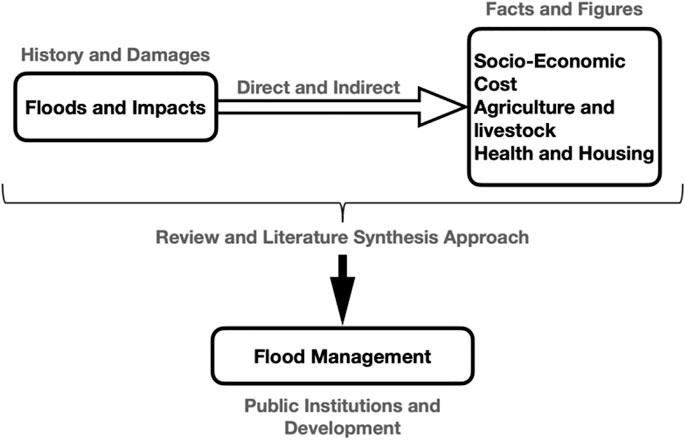- 1Department of Govt and Public Policy, Faculty of Contemporary Studies, National Defence University, Islamabad, Pakistan
- 2Department of Earth and Environmental Sciences, Bahria University, Islamabad, Pakistan
- 3School of Economics, Sapienza University of Rome, Rome, Italy
- 4Department of Environmental Sciences, Faculty of Life Sciences and Informatics, Balochistan University of Information Technology, Engineering and Management Sciences, Quetta, Pakistan
- 5School of Public Administration, Xiangtan University, Hunan, China
- 6School of Public Administration, China University of Geosciences, Wuhan, China
- 7The Faculty of Biosciences, Fisheries and Economics, UiT The Arctic University of Norway, Tromsø, Norway
- 8Department of Earth Sciences, Faculty of Sciences, Ibn Zohr University, Agadir, Morocco
- 9MARE-Marine and Environmental Sciences Centre—Sedimentary Geology Group, Department of Earth Sciences, Faculty of Sciences and Technology, University of Coimbra, Coimbra, Portugal
Flood is one of the most damaging natural disasters as the recent floods have shown their serious impact on Pakistan. Flood control and regulation policies are essential to reduce the risks of economic downturn, a threat to human existence, and to sustain the ecology. The severity of flood catastrophe activities represents a constant and severe issue in the world. Floods are rising year by year in severity and duration, causing negative impacts on the social and economic conditions of the nation concerned. While the frequency of floods cannot be avoided, their adverse impacts can be considerably reduced by adopting careful planning and efficient training. This paper reviews the socioeconomic impact of floods, and the existing condition of flood control policies outlines the flood protection problems and discusses opportunities for successful and efficient flood control in Pakistan. The paper also intends to propose several suggestions for efficient and sustainable flood control in Pakistan.
1 Introduction
Floods are one of the major sources of anthropological and ecological destruction. It affects the socio-economic conditions, worsens public health, generates unemployment, damages the ecosystem, etc. (Allaire, 2018; Parida, 2019). Currently, public and private institutions are struggling to formulate and evaluate risk management and adjustment strategies, involving systems for flood prevention and advance alerts with urbanization patterns and land use planning under consideration in the wake of urban flooding. One major reason is the land adjudication and administration system of Pakistan is colonial in nature and lacks judicial augmentation, providing a chance for flawed urbanization (Shafi et al., 2022). However, policymakers face substantial hiccups in the mitigation of natural disasters’ aftermath globally. In this wake, countries with stable economic structures and administration have reported fewer mortalities and lower socioeconomic damages as compared to developing countries (Anbarci et al., 2005; Kahn, 2005).
Certain approaches are utilized to manage floods and mitigate their aftermath. Here, Effective Risk Avoidance involves a detailed understanding of the effects of floods on the public, the economy, and the efficiency of disaster management strategies. The realistic approaches focus on the potential risks and benefits analysis. Currently, prevention approaches are often decided based on active expert analysis of floods. However, cost-benefit analysis is seldom used in mitigation planning, possibly because of insufficient empirical evidence on a broad range of types of losses. Government and non-governmental sectors also transfer their resources from production to restoration and rehabilitation practices which slow down the growth of Gross Domestic Product (GDP) and overall Human Development Index (HDI) (Sadia et al., 2013; Isik et al., 2021).
The South-Asian Subcontinent, with The Great Himalaya Glaciers, remains at primary risk. Though currently, the rainy season remains the major reason for the flooding in the region the presence of glaciers and the rise in average temperature remain a permanent threat to the region. Floods are the most common natural disaster in the region with 40% occurrence rate (Chaudhry, 2017). Furthermore, urban flooding reasoned by solid waste management and decreases in urban vegetation has affected 9.6 million people in Bangladesh, India, and Nepal, with 6.8 million from India only. South Asia floods: 9.6 million people swamped as humanitarian crisis deepens (IFRC, 2020).
It has been observed that the average global temperature has been rising at a higher rate since 1980. Due to this glaciers are melting rapidly, generating glacial lakes and associated hazards. Glacial Lake Outburst Floods (GLOFs) are extremely destructive because of large volumes of water flowing in narrow river channels. The greatest number of GLOFs, out of all the natural disasters that have occurred worldwide, have been reported in Central Asia (Carrivick and Tweed, 2016; Nie et al., 2017; Mohanty and Maiti, 2021). Global warming as the sole reason GLOFS, the Hindukush-Karakoram-Himalaya regions of Pakistan, which contribute more than 50% of the entire flow of the Indus River System (a major water system), has observed a higher melting rate of glaciers. This condition has led to an increase in the frequency of glacial-related hazards in this Himalayan region. GLOFs which are either caused by the sudden failure of the “dams,” or in the absence of the dams release huge volumes of water and debris wreak havoc downstream. GLOFs have the potential to massively harm people living in the Himalayan region, especially Indus River Basin (Ashraf et al., 2012; Ashraf et al., 2021; Ahmad et al., 2022).
Achieving sustainability in the country in terms of economic, social, political, and environmental issues is discussed more thoroughly nowadays because the phenomena of globalization as well as global warming are based to meet today’s requirements without compromising the ability of future generations (Işık et al., 2021). The rising CO2 emission worldwide will be rising government spending as the result increases real GDP per capita. So, state policymakers are trying to limit or minimize CO2 emissions (Işık et al., 2022). Pakistan is among the most vulnerable countries to floods and water-related disasters as Pakistan has the most glaciers outside the arctic circle. The climate changes and monsoon season have significant impacts on socio-economic degradation, specifically on agricultural production and livestock. The regular occurrence of flood catastrophes affects different regions of Pakistan (See Table 1). Floods are expensive environmental disasters, leading to property and agricultural land destruction. Floods are typically short-lived occurrences that can occur with a tiny alert (Commission, 2007). Pakistan has experienced an unprecedented increase in floods in the last 20 years. Fifty-four (54) floods of differing intensity hit Pakistan, placing it 10th on Global Environment Risk Index (Kreft et al., 2015; Rehman et al., 2015; Sardar et al., 2016). Pakistan is positioned within a hazard-prone region and is bare to a variety of natural catastrophes like floods (Rafiq and Blaschke, 2012). The past of the region’s flooding is relatively lengthy. Many significantly disastrous floods caused considerable harm to economic development. Table 2 provides the history of floods in terms of losses incurred. Each flood is caused by heavy rainfall in the Indus River catchments and its main tributaries (GoP Annual Flood Report, 2017). According to the World Health Organization (WHO) twenty (20) million residents in seventy-eight (78) areas were affected by 2010 floods, taking one thousand eight hundred (1800) life’s, causing damage, or destruction of nearly two million houses with a cumulative cost of $9.7 billion. Public infrastructure i.e., roads, bridges, hospitals, schools etc., were immensely affected, deteriorating accessibility to health, education and mobility resulting in poverty, deprivation, and psychological and social trauma necessitating rehabilitation and restoration (Sardar et al., 2016).

TABLE 1. Most vulnerable districts of Pakistan for flood and flash flood (NDMA, 2019).
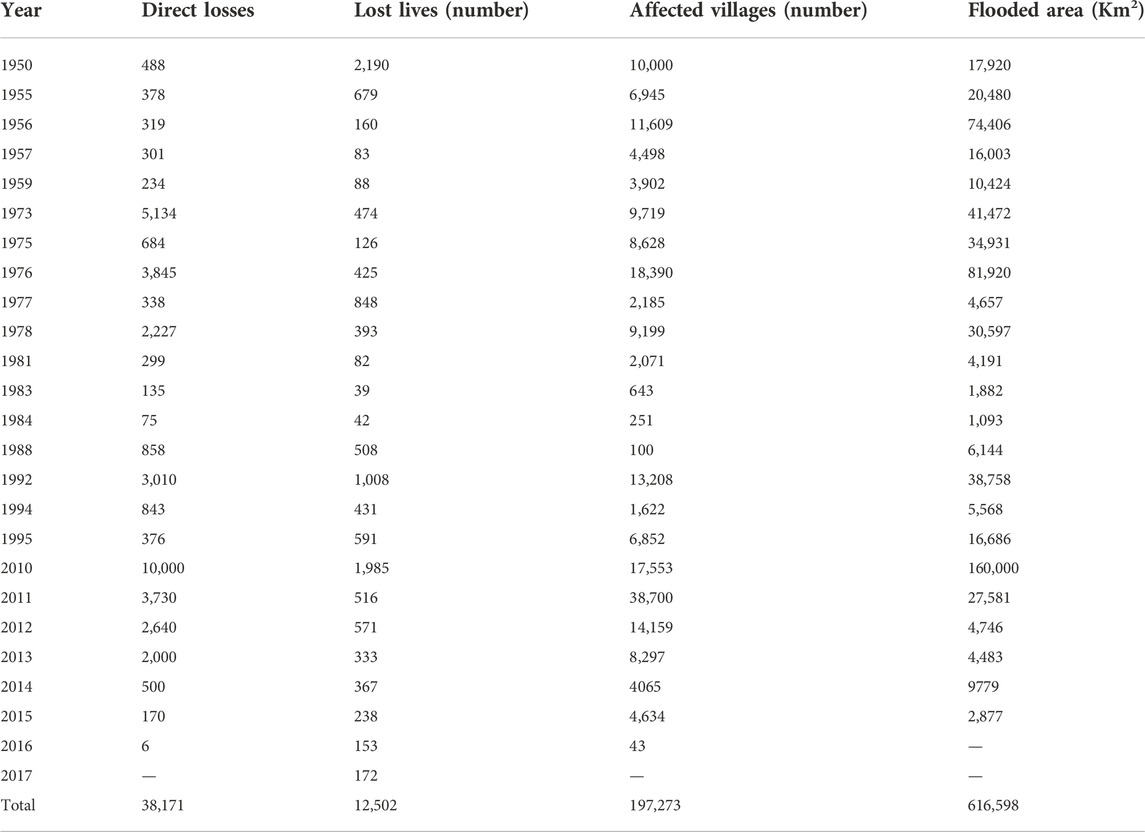
TABLE 2. Historical flood damages in Pakistan (period 1950–2017) (GoP Annual Flood Report, 2017).
There are typically five forms of flooding frequently occurring in the country, such as flash floods, river floods, tidal floods, marine floods, and pluvial floods. The heavy rainfall in canals’ catchment areas triggers pluvial floods of canals or dams, and water goes out towards the dry land and affects the area (Yaqub et al., 2015). Main floods in Pakistan are linked with the low depression monsoon rainfalls that form in the Bay of Bengal and spread west/northwest through India to Pakistan (Kronstadt, 2010). Apart from Monsoon rains, meltdown of glaciers causes flashfloods in hilly areas rendering massive destruction. However, urban flooding is solely related to monsoon rains and unplanned urbanization restricting drainage passages and encroachments. Furthermore, coastal floods are mostly caused by tropical storms in South-East Sindh and Makran regions (Yaqub et al., 2015). Pakistan faces severe floods from July to September period owing to heavy monsoon rains in all the regions of Pakistan inundating the Indus River Basin. Hydrologically, the region can be categorized into three main divisions: Indus Basin, Kharan Basin, and Makran Coastal Drainage Zone. Such basin’s flooding features differ significantly and require a detailed understanding (Tariq and van de Giesen, 2012). The flood hazard map indicates the most vulnerable districts of Pakistan with major river systems (developed after (NDMA, 2019) as shown in Figure 1. A topographic map of Pakistan with recent flood events is shown in Figure 2. The list of the most vulnerable districts of Pakistan concerning Flood and Flash Flood is shown in Table 1. The geographical distribution of Pakistan’s 2010 floods’ direct and indirect damages is shown in Figure 3 and Figure 4 respectively.
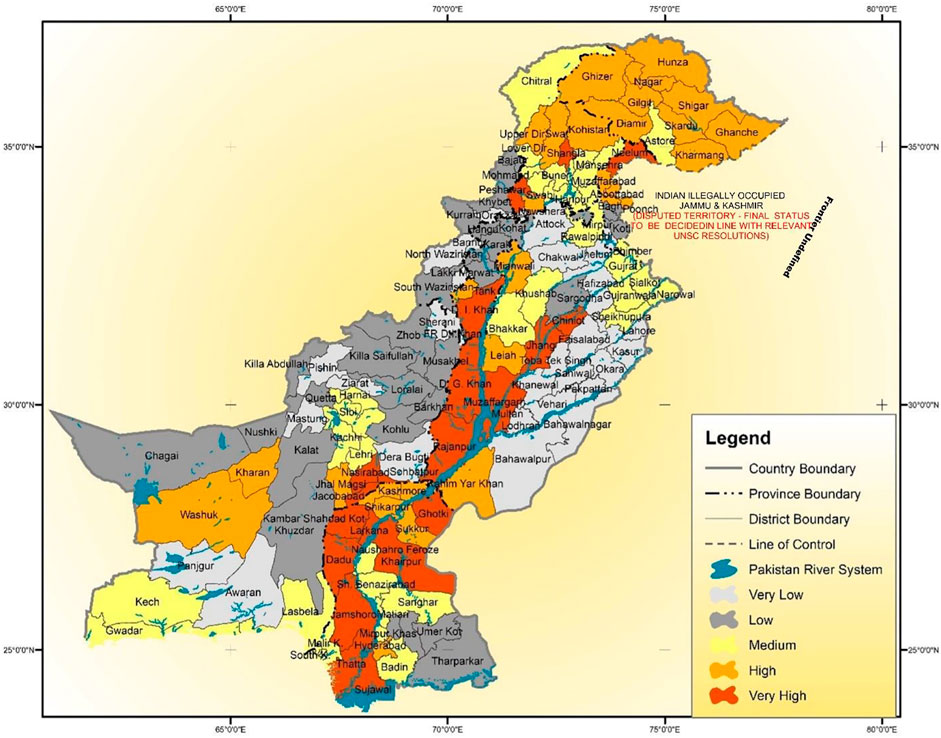
FIGURE 1. Flood hazard map indicates the most vulnerable districts of Pakistan with a major river system map developed after (NDMA, 2019).
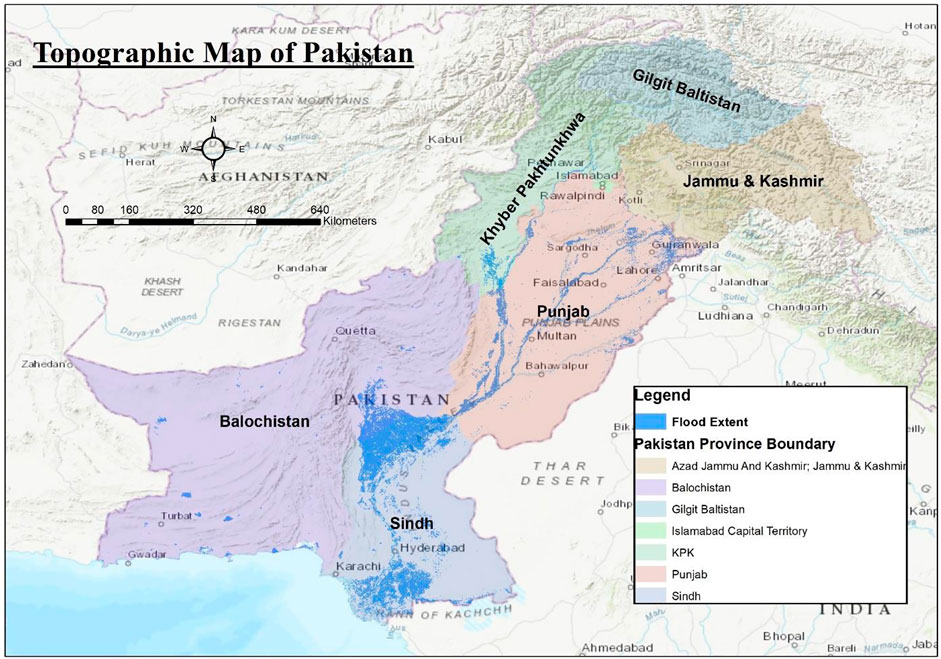
FIGURE 2. Topographic map of Pakistan with recent flood events (Source: ESRI topographic layer used).
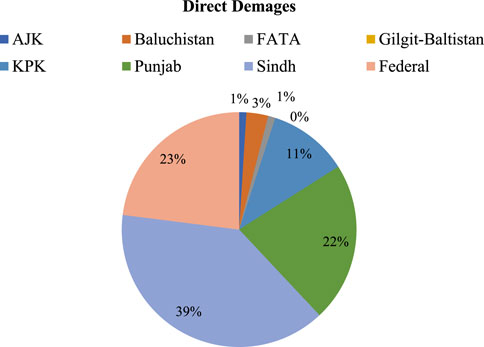
FIGURE 3. Geographical distribution of Pakistan’s 2010 floods direct damages; Source: Pakistan floods 2010 preliminary damage and needs assessment (Asian Development Bank, 2010).
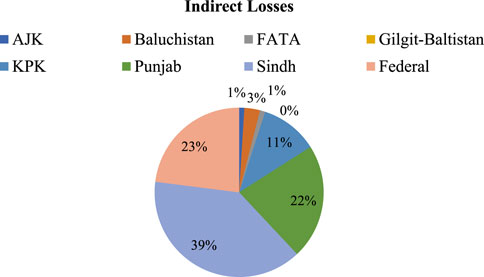
FIGURE 4. Geographical distribution of Pakistan’s 2010 floods indirect damages; Source: Pakistan floods 2010 preliminary damage and needs assessment (Asian Development Bank, 2010).
Global Warming and climate change are serious issues, concerning Pakistan. Our article represents the impact of global warming and climate change. As evident the cloud bursting phenomenon is quite new for Pakistan, the same is the case with Glacier Bursts. Keeping floods as the focal point of the study we maintain this proposition that climate change is one of the primary reasons for wreaking havoc in Pakistan. With this background, this article examines the recent and emerging developments in catastrophe situations to evaluate the effects of floods on the socio-economic conditions of the higher flood-risk areas. The purpose of this study is to assess the socioeconomic cost of floods and to strengthen flood control policies in Pakistan, which is a resource-limited and vastly populated developing nation, and highly dependent on the agricultural sector. The paper utilizes a literature synthesis approach, extracting data from various resources ranging from published articles to government documents. Moreover, ESRI topographic layer was used to develop a topographic map of Pakistan. The study emphasizes that exploration of flood mitigation criteria is also needed as the floods in the country are becoming more regular and severe.
2 Material and methodology
This study reviews the existing literature on the flood, flood management, and socioeconomic cost in Pakistan focusing on riverine and extreme floods (2010). The theoretical framework of the study is shown in Figure 5.
The present study compiled and comprehensively analyzed numerous scientific and analytical reports, scholarly articles relevant to flood management studies, economic surveys of Pakistan, and other relevant reports released by different scholarly, consulting, and consultant institutions to extract and synthesize main studies on floods and flood management in Pakistan. A comprehensive empirical literature review was performed by using Google Scholar and a related search engine. The literature that has the greatest relevance to Pakistan was cited. The study also reported crucial findings and suggestions.
The past research suggests various review methods, empirical analysis, and meta-analysis (Toya and Skidmore, 2007; Jonkman et al., 2008; McMullen and Lytle, 2012). The studies aim to create an empirical link by collecting data such as the impact of floods on GDP (Kirigia et al., 2004; Rufat et al., 2015). But in the case of Pakistan, the data available is insufficient to either adopt or develop any complicated method, however empirical analysis of the facts and figures provided through reports, government documents, and policy papers, and correlate these with studies reviewed. The focus of this study remains to provide insight into the flood problem by reviewing it through data synthesis and textual analysis approach, which will access the impacts of floods. This study will establish an understanding of the importance of the topic, where impact analysis will ensure the need for extended studies conducted in the Netherlands and Africa (Kirigia et al., 2004; Jonkman et al., 2008).
3 Floods and their impacts
Our study will steer through past research which includes a broad range of topics concerning measuring the impact of floods i.e., agriculture and livestock, impact on human health, the economic cost of floods, flood forecasting, flood warning mechanisms, and flood management.
As, the recent floods have devastated the country, and have inundated more than 40% of Pakistan, we can only speculate the losses in wholistic terms. It has been recorded that more than 30 million people have been displaced, with most parts of the Sindh province remaining under imminent threat. So currently, the estimates can only be compared in terms of Macro losses, like no. of people migrated, an area inundated, infrastructure destruction, etc. but the exact figures will remain ambiguous. As far as the scale and scope of the current flood are concerned, we can only conclude this fact that it has immensely damaged the country as compared to the flood of 2010.
3.1 Impact on agriculture and livestock
The impact of the flood on the agriculture sector can be divided into the following six categories: 1) Livestock evacuation in an urgent situation; 2) Avoidance of spring field exposure, allowing livestock to be sheltered or moved to certain other flood-free places; 3) Harm to crop and grass productivity in worst-affected areas with massive loss of pasture 4) Driven production loss and affected the performance of cultivation and agricultural land; 5) Destroyed irrigation structures and facilities at the farm; 6) Loss of advantageous soil invertebrates, in particular earthworms, elevated risk of animal disease, including infection of liver fluke (Morris and Brewin, 2014). As agriculture remains the largest sector of Pakistan’s economy, employing 43 percent of the population, its yearly contribution to the GDP period 1969–2011 is shown in Figure 6.
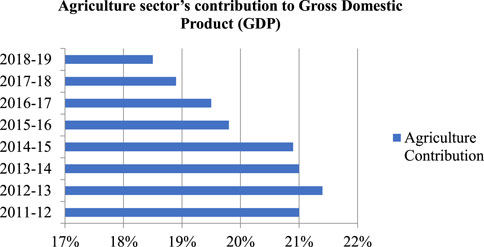
FIGURE 6. Agriculture sector’s contribution to gross domestic product (GDP) period 2011–2019 (Economic Survey of Pakistan 2018–2019) (Gop Pakistan Economic Survey, 2019).
Climate change typically has minor effects on the world food supply, but the consequences of climate change are widely distributed unevenly. Low-income economies, such as those in South Asia and Africa, experienced most of the casualties. By taking the data from 1989 to 2015 and by using the Feasible General Least Square (FGLS) model (Ali et al., 2017) studied the climate changes impact on Pakistan’s major crop yields. The results showed that except for wheat, the impact of rainfall on the production of any other selected crop is negative (Iqbal et al., 2018). Evaluated the impact of Pakistan’s 2010 flood on Khyber Pakhtunkhwa’s agriculture sector and found that after the flood, the family income of agricultural labor dropped, resultantly, in the usage of chemical fertilizers and other agricultural inputs also declined. The floods have adversely affected agricultural output where there was a considerable fall in wheat, maize, and sugar cane output. In Pakistan, the floods and heavy rains have not only affected agriculture crops, livestock, and forests but also devastated necessary facilities such as tube wells, domestic water storage facilities, animal shelters, private seeds inventories/pesticides, and agricultural equipment (Iqbal et al., 2018). Baluchistan and KPK experienced mostly heavy rains, while Punjab and Sindh experienced mostly slow-rising floods on the canal. 2011, 2012, 2013, and 2014s floods damaged residential and agricultural properties, livestock, and crops. (Ashraf et al., 2013). proposed that floods made food shortages and food insecurity for the citizens as they had to utilize polluted resources, particularly water.
Due to the 2010s flood, the agriculture industry has suffered a total loss of about Rs. 429 billion. For example, the profitability of cotton production decreased to 11.76 million bales as compared to the expected production of 14 million bales. Rates of the inputs of agricultural products such as urea, and chemicals, diesel had increased dramatically (Bukhari and Rizvi, 2017). According to (Rehman et al., 2015), twenty percent of the country’s overall landmass was inundated, affected by the 2010s flood, with cumulative damages of above USD 10 billion. The agriculture sector’s contribution to GDP is shown in Table 3 showing a significant decrease in the fiscal year 2010–11.

TABLE 3. Agriculture sector’s contribution to gross domestic product (GDP) period 1969–2011 (Economic survey of Pakistan, 2010–2011) (GoP Economic Survey, 2011).
The flood caused the loss of millions of livestock including around 200,000 dead in the 2010 flood in Pakistan. The final number of losses was higher. The Food and Agriculture Organization (FAO) announced that after the disaster, millions of surviving animals were confronting a food shortage situation that was alarming. The call for 5.7 million dollars has been made by UNO for emergency assistance for livestock. However, funds of 1.4 million dollars have been mobilized by FAO to secure feedstuff and the healthcare of livestock. Currently, the full scale and scope of the catastrophe are not clear, which will require more resource allocations once the situation becomes clearer (Deen, 2015).
3.2 Impact on human health
Floods pose an enormous challenge to the healthcare system and its efficacy. For example, it can damage access to drinkable water by infiltrating the aquifers, thus increasing the transmission of waterborne diseases. The health concerns are classified as direct and indirect. Where direct effects arise from deep water and flooding penetration, including death, debris injury, environmental pollution, and hypothermia. Indirect effects include threats related to the water disruption to the natural and physical environment, including communicable diseases, obesity, famine-related diseases, and displaced population-related diseases. The number of people affected by the different diseases by the 2010’s flood is shown in Figure 7 (Ahern et al., 2005; Du et al., 2010).
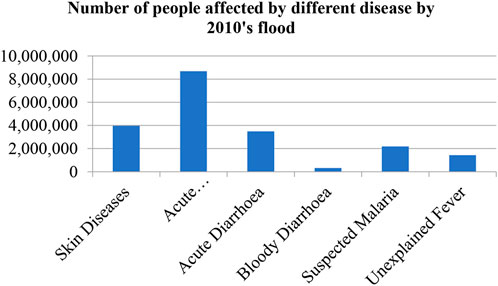
FIGURE 7. Number of people affected by the different diseases by the 2010’s flood (GoP, 2011).
The floods’ health effects could also be categorized as instantaneous medium and long-term. Flooding can also develop a high number of breeding grounds for insect and infection-borne diseases such as malaria. There have been various reports of increased risk throughout Asia, Africa, and Latin America in historically tropical countries. Public medical professionals and relief workers also warn after natural disasters that the dead bodies of affected people can trigger disease outbreaks such as cholera. The anxiety induced by such statements enables societies, local governments, and institutions to dispose of affected people quickly without identification. This leads to psychological stress for family members alive and causes legal issues including land, insurance claims, and inherited wealth (Kondo et al., 2002; Morgan et al., 2005).
Reacher et al. (2004) evaluated the impact of floods on public health by taking the data of massive floods for the period of 12 October 2000 in the region of Lewes in the south of England. They found that floods are linked with an earache, psychological distress, and gastroenteritis. Psychological damage may illustrate some of the additional physical illnesses recorded by affected people, and likely even by children. Strategies to encourage the adaptation of the community to disasters, where flood management has deteriorated will provide logistical assistance for flood victims and adequate therapeutic help. However, in Bangladesh, studies conducted on the causes and spread of diarrhea at the expense of flooding. It highlighted the important demographic, economic, and social aspects from the preview of amenities provided by the system and how the provision of food and clean drinking water becomes essential during and after flooding (Kunii et al., 2002).
The prevalence of diarrheal disease and its associated epidemiological factors were examined by (Mondal et al., 2001), by applying a systematic random sampling analysis on the data of two identified flood-prone regions in West Bengal’s Midnapur area. The research found the diarrheal disease to be the most severe morbidity in flood-prone communities. Some habits, such as using pond water for utensil washing and cooking purposes, hand washing after soap-less defecation, inadequate washing hands before feeding, open area defecation, storing of drinkable water in large mouth containers, etc., were found to be correlated with increased diarrhea attack levels, both in research and control community during flooding to the pre-flooded period (Mondal et al., 2001).
Access to medical care and drugs is of central concern in the flood-affected areas of Pakistan, as is the reconstruction of community health facilities in the region. According to the WHO, 2010s flood affected more than 20 million people, many of whom were homeless. At that time, at least 8 million people required urgent humanitarian aid. More than 400 of the approximately 3000 clinics and hospitals in flood-affected areas had been affected or closed, thereby restricting the availability of urgent and daily healthcare. The availability to clean water for drinking and standards of health and safety were severely affected, though the risks of occurrences of waterborne diseases. Specific health issues, such as tuberculosis, skin diseases, severe respiratory diseases, and starvation, were of utmost concern (WHO, 2010).
3.3 Economic cost of floods
The future of the world economy is more uncertain than it has ever been, and this uncertainty is sensitive to uncertainties relating to a range of economic policy decisions made by all parties involved, including governments (Işık et al., 2019). Natural climatic risks have direct interaction with core macroeconomic factors and can affect economic development and market performance rapidly. Jonkman et al. (2008) described a framework established for the assessment of flood damage in the Netherlands and suggested that the economic loss resulting from the floods relies on the country’s vulnerable location, coastal zone, and economy. According to (Toya and Skidmore, 2007), high-income economies, high schooling, more transparency, more robust financial structures, and reduced government suffer fewer casualties from natural disasters. They argue that private preference for safety nets rises because of increasing people’s wages because higher salaries encourage individuals to mitigate the danger by investing extra in precautionary measures.
With improved GDP growth, citizens could have improved facilities, alarming networks, and flood-prone precautionary and protective steps that can mitigate the effect of floods. Sadia et al. (2013) examined the impact of natural disaster deaths on Pakistan’s GDP per capita from the disaster by taking the data for the period 1975 to 2009, using the ordinary least square model, and found a strong positive impact on per capita GDP from disaster-related deaths, human capital, and life expectancy.
Ahmad et al. (2011) proposed that two levels of flood damage could be evaluated. The harm to facilities (infrastructure) and mortality can be called the first tragedy accompanied by second disasters like the families facing poverty due to the death of earning hands. The risk of the second catastrophe may be higher than that of the first. The risk of natural hazards along with people’s socio-economic insecurity presents a major threat to the system of Pakistan’s government.
Sardar et al. (2016) discuss three threats linked to floods: death, property destruction, and non-fatal community consequences, and calculated the effect of these disasters on Pakistan’s GDP growth for the duration 1972–2013. Their results showed that the per capita GDP development and emergency prevention reduce the severity of flood risks associated with it. Most notably, and contrary to evidence from several nations, flood intensity accentuates flood-related hazards in Pakistan which indicate a lack of understanding of previous flood experience. Concerning the flood-to-economic growth connection, their analysis showed that flood-related threats have a substantial negative effect on the economy’s GDP performance. Property loss causes economic development with the greatest effects.
3.4 Housing
According to the economic survey of Pakistan in 2011, approximately 392,786 houses were affected, and 728,192 were lost. In the districts of Muzaffargarh and Rajanpur in Punjab, Nowshera, and D. I. Khan in KPK and Jaffarabad, Jacobabad, Shikarpur, and Thatta in Sindh, the harm was more noticeable also shown in Figure 1 and Table 1. The geographical distribution of Pakistan’s 2010 floods direct and indirect showed in Figure 3 and Figure 4, respectively. The flood damages and reconstruction costs by sector as shown in Table 4.
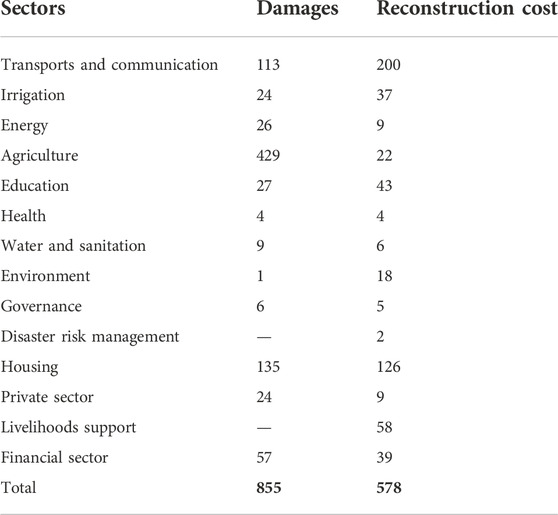
TABLE 4. Flood damages and reconstruction cost by sectors (Rs. in Billion) (Pakistan: Flood Impact Assessment, 2011).
4 Flood management in Pakistan
The flood prevention strategy is a relatively complicated problem in Pakistan. In each of the four provinces, the complexity of the issue differs because of their specific physiographic, climatic, geographical, and socioeconomic circumstances (Chaudhri, 1981). Early severe flooding happened in 1950, 1956, and 1957 after independence. However, no systematic flood control program was implemented at the national level, owing to scarce funding and administrative structures. Protection and control of flooding remained the exclusive responsibility of regional governments until 1976. That improved after 1973 destroying floods that took 474 lives and caused damage of 160 billion Pakistani Rupees (Tariq and van de Giesen, 2012).
4.1 Evolution of flood management system in Pakistan
In 1973 Pakistan faced severe floods which led to the establishment of the Federal Flood Commission (FFC) in 1977. The commission worked under the Ministry of Water and Power and was established to implement nationwide flood management, particularly concerning the Indus River Basin. The main functions of the FFC include developing national flood management measures; approving flood management plans drawn up by local governments and federal entities; examining flood damage to facilities in the public sector, and analysis of repair and rehabilitation plans; flood forecasting, and alert program enhancement measures; providing guidelines on standards for the management of flood protection reservoirs (GoP Annual Flood Report, 2009).
The first National Flood Protection Plan (NFPP-I) was developed after the creation of the FFC, with a spending timeline to be introduced throughout the 1978–1988 decade. A Federal Coordination Cell (now reshaped as FID Cell) was formed in 1982 to organize the Provincial Irrigation Departments ' operations, especially in the drainage region. In 1987 Dam Protection Council was set up to examine established dams via DSO WAPDA and proposals for new dams etc. (GoP Annual Flood Report, 2009).
In Pakistan, flood control initiatives consist primarily of flood-protection embankments, spurs, studs, and sophisticated flood-prediction strategies. The provincial governments have developed numerous flood-protection systems to address local flood challenges (Baig, 2008). According to Ahmed et al. (2014) flood risk reduction in Pakistan was handled primarily by federal and provincial authorities, which typically need to be reconsidered to find innovative methods and strategies to counter the threat. Flood management institutions and their responsibilities are presented in Figure 8.
4.2 Flood warning system in Pakistan
According to Jain et al. (2018), Flood Forecasting and Warning System (FFWS) main aim is to inform the public and other stakeholders of an imminent flood as early and effectively as possible. In Pakistan, the mechanism of flood warning and control undertakes three phases: 1) The PMD tracks the monsoon weather pattern, which produces either from the west in the Arabian Sea or from the East in the Bay of Bengal, in the first stage. Their movements are monitored for the upper catchments lying in Pakistan or over the border, and estimates are generated one to 2 days in advance for expected rains and the severity of such rains. In the case of rains, the volume of rainfall is estimated and evaluated above the rim stations for their possible run-off relationship) after that is the stage of flood creation that starts with the generation of runoff from the rim stations and flows down into the Indus River and its tributary. Projected rainfall and flow data and real upstream flows are the hydro-meteorological portions of the flood prediction method 3) ultimately, the hydrological part of the forecasting network is to track and control the route of the flood wave below the rim station of the rivers at the downstream locations. This is handled by WAPDA and controlled in respective provinces by the irrigation departments (Hussain, 2015).
The early warning system of Pakistan is efficient to some extent; however, the flood warning system only aims to provide information, rather protective measures. In our opinion, as we have also mentioned in the study, such acts can only help lessen the losses to be incurred. However, the implementation in the form of evacuation, protection, and migration is based upon the behavioral choices of the people of the area. We can mention the example of Mardan, where legal force was used to vacate the city during the 2022 floods. Thus, flood warning system calculates and provides relevant information. However, the impact must reach the grassroots level, furthermore, there is a strong need of creating a civic sense among the people of Pakistan. As can be seen in the case of Sawat River flash floods, it is speculated that most of the socio-economic loss incurred was caused by illegitimate activities, land grabbing on the riverbed, and around the torrent flow, which was against the River Protection Ordinance, 2002.
4.2.1 Flood forecasting division’s flood forecasting models
The FFD employs the Flood Early Warning System (FEWS) and the Indus Integrated Flood Analysis System (IFAS) for flood forecasts. In terms of urban areas, flood prediction and warning systems were developed in the Nallah Lai Basin (Afsa et al., 2013; Sugiura et al., 2014). Since 2007 the FFD has used the flood forecasting framework FEWS built by Delft Hydraulic in the Netherlands. The FEWS contains (1) the rainfall-runoff interface Sacramento Soil Moisture Accounting (SAC-SMA) and (2) the SOBEK, an interface for hydraulic fluid routing (Shrestha et al., 2019). The Layout contains data from forty-four (44) WAPDA telemetry stations. The rainfall-runoff process performance determines the entrance into the routing mechanism (Awan, 2003). Early warning mechanism components are shown in Figure 9.
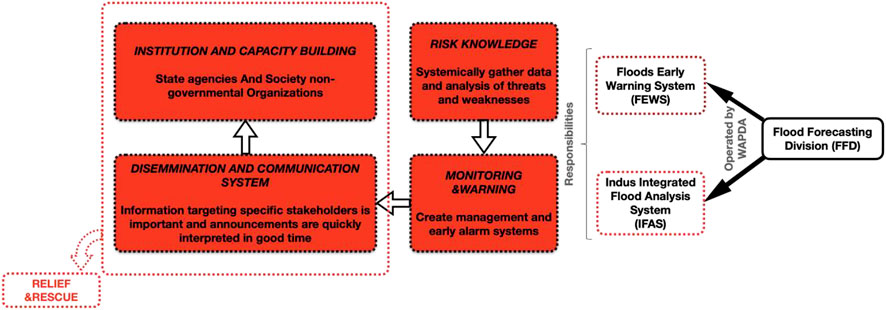
FIGURE 9. Early warning mechanism components (Hussain, 2015).
From the perspective of South Asia, the hierarchical institutional structure Flash Flood Guidance System with Global Coverage (FFGS) can provide warnings about 6–24 h in advance for South Asian countries, including India, Nepal, Bhutan, Bangladesh, and Sri Lanka. However, the respective NDMA’s of these countries perform the same functions as Pakistan, Since Bangladesh and India are more densely populated than Pakistan, the riverbank protection in India and Bangladesh is much more rooted at the state level, and powers are transferred to the grassroots level for implementation. But, as the cultural roots of the subcontinent remain the same along with legal roots, the implementation and behavioral intention part remain at certain risk.
4.2.1.1 Criticism
The present flood forecasting method of the FEWS model, however, has minimal regional scope, and rainfall-runoff knowledge and downstream routing of the Tarbela and Kabul rivers are not integrated with the model. The tributaries included in the FEWS are not determined by the amount and rate of discharge necessary for reliable flood forecasting (Shrestha et al., 2019). The FFD also introduces the IFAS established by the International Center for Water Hazard and Risk Management (ICHARM) under the Critical Reinforcing of Pakistan’s Flood Warning and Management Capacity Program and the Japan Aerospace Exploration Agency (JAXA), with UNESCO funding. More than thirty-nine (39) districts in Pakistan are protected by flood prediction and early warning services from the IFAS (Ahmad, 2015; Mustafa et al., 2015).
Disaster management institutions in Pakistan are relatively new and need time to strengthen their foothold. National disaster management authority (NDMA) claims a preparedness-oriented approach, but at the core, the country’s disaster management system is still operating on a top-down approach. Practically, it is more relief-focused, and season-based planning is being implemented. Under the 18th amendment of the constitution of Pakistan, PDMAs are not legally bound to follow NDMA. As a result, NDMA just acts as a general policy-defining institution. Mutual coordination needs to be encouraged to cover potential oversights. District disaster management authorities are composed of officials from different local institutions and are virtually non-existent in the field. Thus, a dedicated DDMA is needed, which could act as a catalyst in disaster risk reduction (Rana et al., 2021).
There is also a need for regular technical and institutional capacity assessments for effective disaster preparedness and response. Consequently, ad-hoc disaster risk management is happening in the study areas. More research could be conducted to identify potential weaknesses in these urban institutions. There is a need to improve local institutions’ image in front of communities as strong distrust further complicates flood risk reduction initiatives. Local institutions and communities need to work together to realize the full potential of the disaster management cycle and disaster risk reduction approach (Rana et al., 2021). Flood management institutions and their responsibilities are shown in Figure 10.
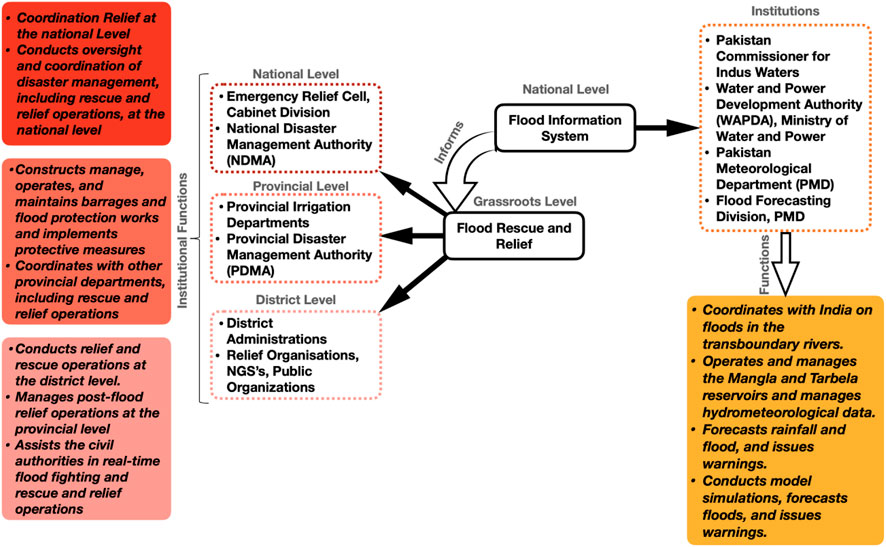
FIGURE 10. Flood management institutions and their responsibilities developed after (Ali, 2013; Rana et al., 2021).
To cope with the situation, there must be a multi-pronged approach, as suggested there is a strong need for water reservoirs, which can be fulfilled through water policy. Secondly, the early warning system and relevant institutions must reach the grassroots level to cope with the emergency in a better way. Thirdly, the whole management machinery of the area remains dependent upon a certain institution, Pakistan Administrative Services. There is a strong to segregate the departmental responsibilities and develop new departments ensuring implementation. Lastly, the citizens must have a civic sense or understanding of the nature of the information provided to them in the wake of floods.
In April 2018, Pakistan’s four provincial chief ministers endorsed the country’s first regional water policy. The National Water Policy’s goal is to address the growing water problem and include an overarching policy structure and recommendations for a robust action plan. The National Water Policy provides a specific policy structure and collection of water protection standards based on which the Provincial Governments will devise their development plans and water conservation, water improvement, and water management projects (GoP National Water Policy, 2018).
5 Conclusion
Floods are a frequently occurring phenomenon due to heavy monsoon rains in Pakistan. The size and magnitude of the floods that Pakistan has confronted in the last few years would have been a problem for any nation. Recent severe floods have shown that there is a lack of adequate cooperation between flood control agencies, due in part to shortcomings in current technological capacities, such as warning signals, preparedness initiatives, disaster response, and systemic flood prevention measures. This is important to further develop flood monitoring and alert systems to reduce the damages of potential floods. Although Pakistan’s flood warning and detection systems have shown their effectiveness, the forecasting ability of the network is still weak. At the same time the institutions, NDMA and PDMA, operate at national and provincial levels, dispersing the rehabilitation responsibilities to local bureaucracy rather than establishing a grassroots-level structure with reference to small cities and villages. It also makes rehabilitation procedures weak and ineffective in most areas. Nonetheless, a cohesive response by the Pakistani community and the combined efforts of all the international and domestic agencies concerned remained crucial. Only providing damage reimbursements to flood victims is not the remedy; we need to get rid of this problem. Pakistan’s water management also needs to develop more reservoirs—lakes, and dams as a way to combat floods. The government should generate and incorporate robust public awareness initiatives to educate the public on flood risks and flood preparedness. In conclusion, to achieve effective flood control, a risk-based proactive strategy is needed.
Author contributions
All authors listed have made a substantial, direct, and intellectual contribution to the work and approved it for publication.
Funding
Open access funding provided by UiT The Arctic University of Norway.
Conflict of interest
The authors declare that the research was conducted in the absence of any commercial or financial relationships that could be construed as a potential conflict of interest.
Publisher’s note
All claims expressed in this article are solely those of the authors and do not necessarily represent those of their affiliated organizations, or those of the publisher, the editors and the reviewers. Any product that may be evaluated in this article, or claim that may be made by its manufacturer, is not guaranteed or endorsed by the publisher.
References
Afsa, M. M., Aslam, K., and Atif, S. “Comparative analysis of flood inu by flood early warning system 2010 floods in Pakistan,” in 5th World Engineering Congress, Islamabad, Pakistan, 2013.
Ahern, M., Kovats, R. S., Wilkinson, P., Few, R., and Matthies, F. (2005). Global health impacts of floods: Epidemiologic evidence. Epidemiol. Rev. 27, 36–46. doi:10.1093/epirev/mxi004
Ahmad, F., Kazmi, S. F., and Pervez, T. (2011). Human response to hydro-meteorological disasters: A case study of the 2010 flash floods in Pakistan. J. Geogr. Regional Plan. 4 (9), 518.
Ahmad, N., Khan, S., Ehsan, M., Rehman, F. U., and Al-Shuhail, A. (2022). Estimating the total volume of running water bodies using geographic information system (gis): A case study of peshawar basin (Pakistan). Sustainability 14 (7), 3754. doi:10.3390/su14073754
Ahmed, B., Wei, S., Fu, Y. G., Shabbir, M., and Nabi, G. (2014). Effects of floods policy in Pakistan and management issues:(case of district dera-ghazi khan). Int. J. Adv. Res. 2 (10), 967–974.
Ali, A. (2013). Indus Basin floods mechanisms, impacts, and management. Philippines: Asian Development Bank, 67.
Ali, S., Liu, Y., Ishaq, M., Shah, T., Ilyas, A., Din, I. U., et al. (2017). Climate change and its impact on the yield of major food crops: Evidence from Pakistan. Foods 6 (6), 39. doi:10.3390/foods6060039
Allaire, M. (2018). Socio-economic impacts of flooding: A review of the empirical literature. Water Secur. 3, 18–26. doi:10.1016/j.wasec.2018.09.002
Anbarci, N., Escaleras, M., and Register, C. A. (2005). Earthquake fatalities: The interaction of nature and political economy. J. Public Econ. 89 (9-10), 1907–1933. doi:10.1016/j.jpubeco.2004.08.002
Ashraf, A., Iqbal, M. B., Mustafa, N., Naz, R., and Ahmad, B. (2021). Prevalent risk of glacial lake outburst flood hazard in the Hindu Kush–Karakoram–Himalaya region of Pakistan. Environ. Earth Sci. 80 (12), 1–12. doi:10.1007/s12665-021-09740-1
Ashraf, A., Naz, R., and Roohi, R. (2012). Glacial lake outburst flood hazards in Hindukush, karakoram and himalayan ranges of Pakistan: Implications and risk analysis. Geomatics, Nat. Hazards Risk 3 (2), 113–132. doi:10.1080/19475705.2011.615344
Ashraf, S., Iftikhar, M., Shahbaz, B., Khan, G. A., and Luqman, M. (2013). Impacts of flood on livelihoods and food security of rural communities: A case study of southern Punjab, Pakistan. Pak. J. Agric. Sci. 50 (4), 751–758.
Asian Development Bank (2010). Pakistan floods 2010 preliminary damage and needs assessment. Islamabad, Pakistan: Asian Development Bank, 188.
Awan, S. A. (2003). In Flood forecasting and management in Pakistan, IUGG, Sapporo. Sapporo: IAHS Publ, 90–98.
Bukhari, S., and Rizvi, S. (2017). Impact of 2010 floods on Pakistan’s Agriculture. J. Environ. Anal. Toxicol. 7 (1), 1–4. doi:10.4172/2161-0525.1000424
Carrivick, J. L., and Tweed, F. S. (2016). A global assessment of the societal impacts of glacier outburst floods. Glob. Planet. Change 144, 1–16. doi:10.1016/j.gloplacha.2016.07.001
Chaudhri, S. A. (1981). In flood characteristics and problems in Pakistan, natural resources forum. Hoboken, New Jersey: Wiley Online Library, 399–407.
Chaudhry, Q. (2017). Climate change profile of Pakistan. Mandaluyong, Philippines: Asian development bank.
Commission, F. F. (2007). Annual flood report. Islamabad, Pakistan: Ministry of Water and Power Pakistan and Federal Flood Commission.
Deen, S. (2015). Pakistan 2010 floods Policy gaps in disaster preparedness and response. Int. J. Disaster Risk Reduct. 12, 341–349. doi:10.1016/j.ijdrr.2015.03.007
Du, W., FitzGerald, G. J., Clark, M., and Hou, X.-Y. (2010). Health impacts of floods. Prehosp. Disaster Med. 25 (3), 265–272. doi:10.1017/s1049023x00008141
GoP Annual Flood Report (2009). Federal flood commission. Pakistan: Islamabad, Pakistan: Ministry of Water & Power, 44.
GoP annual flood report; Federal flood commission, Ministry of Water Resources, Pakistan: Islamabad. Pakistan, 2017; p 118.
GoP Economic Survey (2011). GoP economic survey 2010-11. Islamabad, Pakistan: Government of Pakistan, 14.
GoP National Water Policy (2018). GoP national water policy. Pakistan: Ministry of Water Resources, Government of Pakistan Islamabad.
Gop Pakistan Economic Survey (2019). GoP Pakistan economic survey 2018-19. Islamabad, Pakistan: Government of Pakistan Finance Division.
GoP, W. (2011). Disease early warning system and response in Pakistan. Wkly. Epidemiol. Bull. 2 (29), 1–8.
Hussain, S. S. (2015). Pakistan 2010 floods: Causes and lessons learnt. Pakistan: Islamabad, Pakistan: Oxfam.
IFRC (2020). South Asia floods: 9.6 million people swamped as humanitarian crisis deepens. Kuala Lumpur/Delhi/Dhaka/Kathmandu/Geneva: IFRC.
Iqbal, S., Khan, A. N., Jadoon, M. A., and Alam, I. (2018). Effects of flood-2010 on agricultural sector in khyber Pakhtunkhwa: A case of district charsadda. Sarhad J. Agric. 34 (1), 215–219. doi:10.17582/journal.sja/2018/34.1.215.219
Işık, C., Ahmad, M., Ongan, S., Ozdemir, D., Irfan, M., and Alvarado, R. (2021). Convergence analysis of the ecological footprint: Theory and empirical evidence from the USMCA countries. Environ. Sci. Pollut. Res. 28 (25), 32648–32659. doi:10.1007/s11356-021-12993-9
Işık, C., Ongan, S., Bulut, U., Karakaya, S., Irfan, M., Alvarado, R., et al. (2022). Reinvestigating the Environmental Kuznets Curve (EKC) hypothesis by a composite model constructed on the Armey curve hypothesis with government spending for the US States. Environ. Sci. Pollut. Res. 29 (11), 16472–16483. doi:10.1007/s11356-021-16720-2
Isik, C., Ongan, S., Ozdemir, D., Ahmad, M., Irfan, M., Alvarado, R., et al. (2021). The increases and decreases of the environment Kuznets curve (EKC) for 8 OECD countries. Environ. Sci. Pollut. Res. 28 (22), 28535–28543. doi:10.1007/s11356-021-12637-y
Işık, C., Sirakaya-Turk, E., and Ongan, S. (2019). Testing the efficacy of the economic policy uncertainty index on tourism demand in USMCA: Theory and evidence. Tour. Econ. 26 (8), 1344–1357. doi:10.1177/1354816619888346
Jain, S. K., Mani, P., Jain, S. K., Prakash, P., Singh, V. P., Tullos, D., et al. (2018). A Brief review of flood forecasting techniques and their applications. Int. J. River Basin Manag. 16 (3), 329–344. doi:10.1080/15715124.2017.1411920
Jonkman, S. N., Bočkarjova, M., Kok, M., and Bernardini, P. (2008). Integrated hydrodynamic and economic modelling of flood damage in The Netherlands. Ecol. Econ. 66 (1), 77–90. doi:10.1016/j.ecolecon.2007.12.022
Kahn, M. E. (2005). The death toll from natural disasters: The role of income, geography, and institutions. Rev. Econ. Statistics 87 (2), 271–284. doi:10.1162/0034653053970339
Kirigia, J. M., Sambo, L. G., Aldis, W., and Mwabu, G. M. (2004). Impact of disaster-related mortality on gross domestic product in the WHO African Region. BMC Emerg. Med. 4 (1), 1–9. doi:10.1186/1471-227x-4-1
Kondo, H., Seo, N., Yasuda, T., Hasizume, M., Koido, Y., Ninomiya, N., et al. (2002). Post-flood—Infectious diseases in Mozambique. Prehosp. Disaster Med. 17 (3), 126–133. doi:10.1017/s1049023x00000340
Kreft, S., Eckstein, D., Junghans, L., Kerestan, C., and Hagen, U. (2015). Global climate risk index 2015: Who suffers most from extreme weather events? Weather-related loss events in 2013 and 1994 to 2013. Bonn, Germany: Germanwatche.V, 1–32.
Kronstadt, K. A. (2010). Flooding in Pakistan: Overview and issues for congress. Collingdale, United States: DIANE Publishing.
Kunii, O., Nakamura, S., Abdur, R., and Wakai, S. (2002). The impact on health and risk factors of the diarrhoea epidemics in the 1998 Bangladesh floods. Public Health 116 (2), 68–74. doi:10.1016/s0033-3506(02)00506-1
McMullen, L. E., and Lytle, D. A. (2012). Quantifying invertebrate resistance to floods: A global-scale meta-analysis. Ecol. Appl. 22 (8), 2164–2175. doi:10.1890/11-1650.1
Mohanty, L., and Maiti, S. (2021). Probability of glacial lake outburst flooding in the Himalaya. Resour. Environ. Sustain. 5, 100031. doi:10.1016/j.resenv.2021.100031
Mondal, N., Biswas, R., and Manna, A. (2001). Risk factors of diarrhoea among flood victims: A controlled epidemiological study. Indian J. Public Health 45 (4), 122–127.
Morgan, O., Ahern, M., and Cairncross, S. (2005). Revisiting the tsunami: Health consequences of flooding. PLoS Med. 2 (6), e184–e493. doi:10.1371/journal.pmed.0020184
Morris, J., and Brewin, P. (2014). The impact of seasonal flooding on agriculture: The spring 2012 floods in somerset, england. J. Flood Risk Manag. 7 (2), 128–140. doi:10.1111/jfr3.12041
Mustafa, D., Gioli, G., Qazi, S., Waraich, R., Rehman, A., and Zahoor, R. (2015). Gendering flood early warning systems: The case of Pakistan. Environ. Hazards 14 (4), 312–328. doi:10.1080/17477891.2015.1075859
NDMA (2019). National disaster response plan 2019 (NDRP-2019). Islamabad, Pakistan: NDMA, Government of Pakistan.
Nie, Y., Sheng, Y., Liu, Q., Liu, L., Liu, S., Zhang, Y., et al. (2017). A regional-scale assessment of himalayan glacial lake changes using satellite observations from 1990 to 2015. Remote Sens. Environ. 189, 1–13. doi:10.1016/j.rse.2016.11.008
Pakistan: Flood Impact Assessment (2011). GoP an economic survey of Pakistan 2010-2011’s special section. Islamabad, Pakistan: Pakistan: Flood Impact Assessment, 2.
Parida, Y. (2019). Economic impact of floods in the Indian states. Environ. Dev. Econ. 25, 267–290. doi:10.1017/s1355770x19000317
Rafiq, L., and Blaschke, T. (2012). Disaster risk and vulnerability in Pakistan at a district level. Geomatics, Nat. Hazards Risk 3 (4), 324–341. doi:10.1080/19475705.2011.626083
Rana, I. A., Asim, M., Aslam, A. B., and Jamshed, A. (2021). Disaster management cycle and its application for flood risk reduction in urban areas of Pakistan. Urban Clim. 38, 100893. doi:10.1016/j.uclim.2021.100893
Reacher, M., McKenzie, K., Lane, C., Nichols, T., Kedge, I., Iversen, A., et al. (2004). Health impacts of flooding in Lewes: A comparison of reported gastrointestinal and other illness and mental health in flooded and non-flooded households. Commun. Dis. Public Health 7 (1), 39–46.
Rehman, A., Jingdong, L., Du, Y., Khatoon, R., Wagan, S. A., and Nisar, S. K. (2015). Flood disaster in Pakistan and its impact on agriculture growth (a review). Glob. Adv. Res. J. Agric. Sci. 4 (12), 827–830.
Rehman, H., and Kamal, A. “In Indus Basin river system-Flooding and flood mitigation,” in 8th International River Symposium, Brisbane, Australia, 2-11 September 2005 (Brisbane: IISD), 2–11.
Rufat, S., Tate, E., Burton, C. G., and Maroof, A. S. (2015). Social vulnerability to floods: Review of case studies and implications for measurement. Int. J. disaster risk Reduct. 14, 470–486. doi:10.1016/j.ijdrr.2015.09.013
Sadia, B., Bashir, M. A., Nawaz, M., and Zaman, K. (2013). Effects of disaster-related mortality on gross domestic product in Pakistan. Int. J. Ecol. Dev. 24 (1), 62–80.
Sardar, A., Javed, S. A., and Amir-ud-Din, R. (2016). Natural disasters and economic growth in Pakistan: An enquiry into the floods related hazards’ triad. Islamabad: Pakistan Institute of Development Economics.
Shafi, A., Wang, Z., Ehsan, M., Riaz, F. A., Ali, M. R., Mamodson, Z. A., et al. (2022). A game theory approach to the logic of illegitimate behavior induced during land conflict litigation in urban and peri-urban areas of Pakistan. Cities 130, 103990. doi:10.1016/j.cities.2022.103990
Shrestha, M. S., Khan, M. R., Wagle, N., Babar, Z. A., Khadgi, V. R., and Sultan, S. (2019). “Chapter 13 - review of hydrometeorological monitoring and forecasting system for floods in the Indus Basin in Pakistan,” in Indus River basin. Editors S. I. Khan, and T. E. Adams (Amsterdam, Netherlands: Elsevier), 309–333.
Sugiura, A., Fujioka, S., Nabesaka, S., Sayama, T., Iwami, Y., Fukami, K., et al. (2014). Challenges on modelling a large River Basin with scarce data: A case study of the Indus upper catchment. J. Hydrology Environ. Res. 2 (1), 59–64.
Tariq, M., and van de Giesen, N. (2012). Floods and flood management in Pakistan. Phys. Chem. Earth, Parts A/B/C 47-48, 11–20. doi:10.1016/j.pce.2011.08.014
Toya, H., and Skidmore, M. (2007). Economic development and the impacts of natural disasters. Econ. Lett. 94 (1), 20–25. doi:10.1016/j.econlet.2006.06.020
WHO WHO Pakistan: The health impact of the floods. Available at: https://www.who.int/hac/crises/pak/highlights/september2010/en/. (Accessed December 25, 2021)
Keywords: major floods, flood management, social and economic cost, flood control, flood impacts
Citation: Manzoor Z, Ehsan M, Khan MB, Manzoor A, Akhter MM, Sohail MT, Hussain A, Shafi A, Abu-Alam T and Abioui M (2022) Floods and flood management and its socio-economic impact on Pakistan: A review of the empirical literature. Front. Environ. Sci. 10:1021862. doi: 10.3389/fenvs.2022.1021862
Received: 17 August 2022; Accepted: 22 November 2022;
Published: 01 December 2022.
Edited by:
Cem Işık, Anadolu University, TurkeyReviewed by:
Tengyue Hao, University of Malaya, MalaysiaSaqib Shakeel Abbasi, Pakistan Agricultural Research Council, Pakistan
Majid Nazeer, East China University of Technology, China
Copyright © 2022 Manzoor, Ehsan, Khan, Manzoor, Akhter, Sohail, Hussain, Shafi, Abu-Alam and Abioui. This is an open-access article distributed under the terms of the Creative Commons Attribution License (CC BY). The use, distribution or reproduction in other forums is permitted, provided the original author(s) and the copyright owner(s) are credited and that the original publication in this journal is cited, in accordance with accepted academic practice. No use, distribution or reproduction is permitted which does not comply with these terms.
*Correspondence: Muhsan Ehsan, bXVoc2FuZWhzYW45OEBob3RtYWlsLmNvbQ==; Tamer Abu-Alam, dGFtZXIuYWJ1LWFsYW1AdWl0Lm5v
 Zaira Manzoor1
Zaira Manzoor1 Muhsan Ehsan
Muhsan Ehsan Aqsa Manzoor
Aqsa Manzoor Malik Muhammad Akhter
Malik Muhammad Akhter Muhammad Tayyab Sohail
Muhammad Tayyab Sohail Asrar Hussain
Asrar Hussain Tamer Abu-Alam
Tamer Abu-Alam Mohamed Abioui
Mohamed Abioui